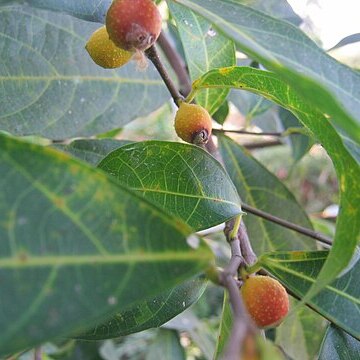Shrubs or woody vines. Branchlets grayish white when dry, rugose, glabrous, subglabrous, or densely white-hairy. Stipules lanceolate-ovate, ca. 8 mm, thinly membranous. Leaves distichous; petiole ca. 1 cm, subglabrous; leaf blade ovate, ovate-elliptic, elliptic-lanceolate, lanceolate, or oblong, 8-12 × 3-4 cm, ± leathery, both surfaces glabrous or abaxially sparsely brown pubescent, base rounded to broadly cuneate, margin entire, apex acute to acuminate; secondary veins 4-12 on each side of midvein, and abaxially slightly raised, tertiary veins honeycomblike. Figs axillary on leafy or on leafless branchlets, solitary or occasionally paired, blackish purple when mature, globose, ± globose, or conic, sometimes slightly depressed, 0.5-2 cm in diam., glabrous, sparsely pubescent, or densely covered with brown hairs, inside with bristles, apical pore slightly concave, sessile or pedunculate; peduncle 0.5-1.5 cm or shorter; involucral bracts triangular, triangular-ovate, or ovate-lanceolate, 2-6 mm, with scattered bristles. Male flowers: near apical pore, pedicellate; calyx lobes 3 or 4, oblanceolate; stamens 2; filaments very short; anthers mucronate. Gall flowers: pedicellate; calyx lobes 4, obovate-spatulate; ovary elliptic; style short; stigma shallowly funnelform. Female flowers: pedicellate; calyx lobes spatulate; ovary obovate; style subapical; stigma thin and long. Achenes ovoid-ellipsoid, with adherent liquid. Fl. May-Jul.
More
A fig. It is a climbing shrub or woody vine. The shoots are hairy. The branches develop roots. The leafy structure near the base of the leaves is sword shaped and about 8 mm long. The leaves are alternate. They are 8-12 cm long by 3-4 cm wide. They are oval. They are hairy underneath. There are 5-10 pairs of side veins. The base is rounded. The figs are round or slightly flattened. They are 0.5-2 cm across. They occur singly or occasionally in pairs. They are in the axils of leaves or on leaf less branches. They are purple when ripe. The fruit stalk is 0.5-1.5 cm long. Male and gall flowers are in the one fig and female flowers in other figs. There are some varieties described based on bract, leaf and fig shape and size.

